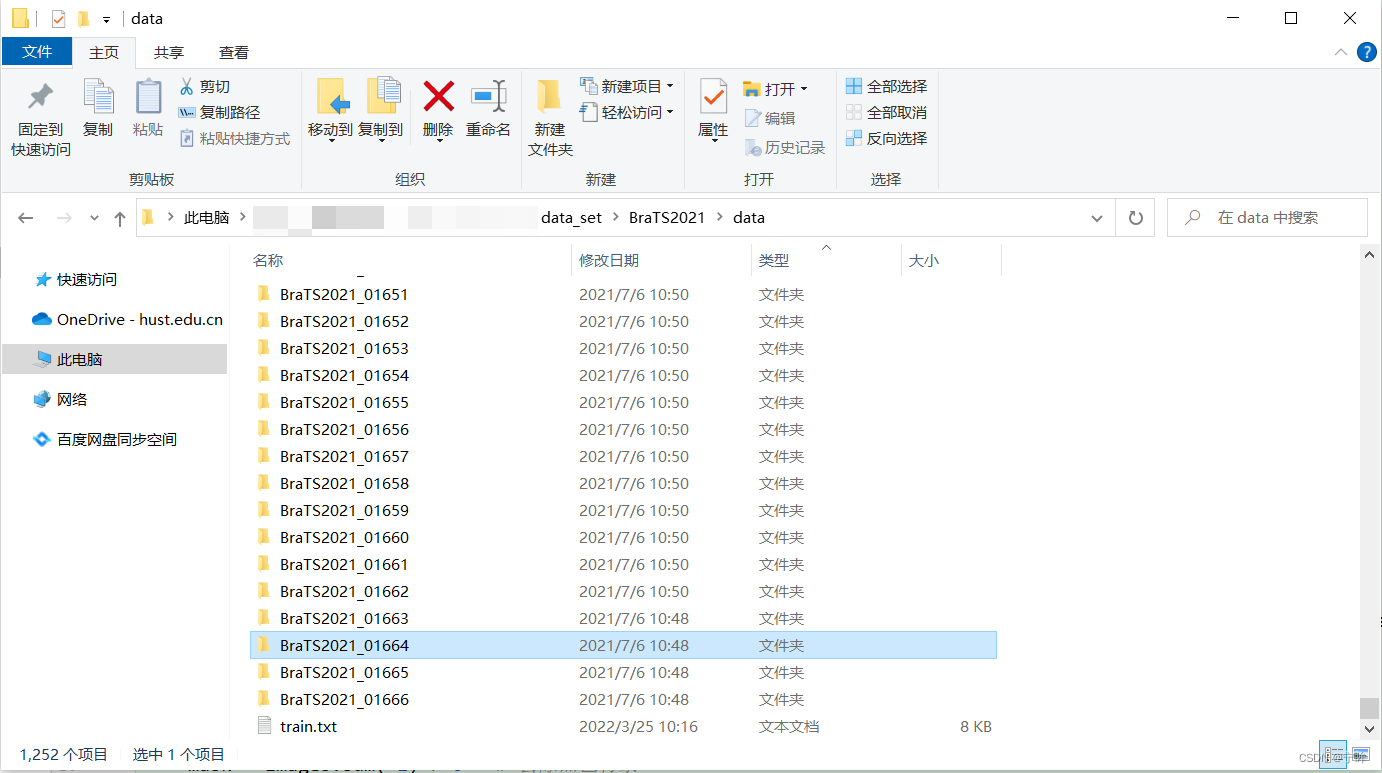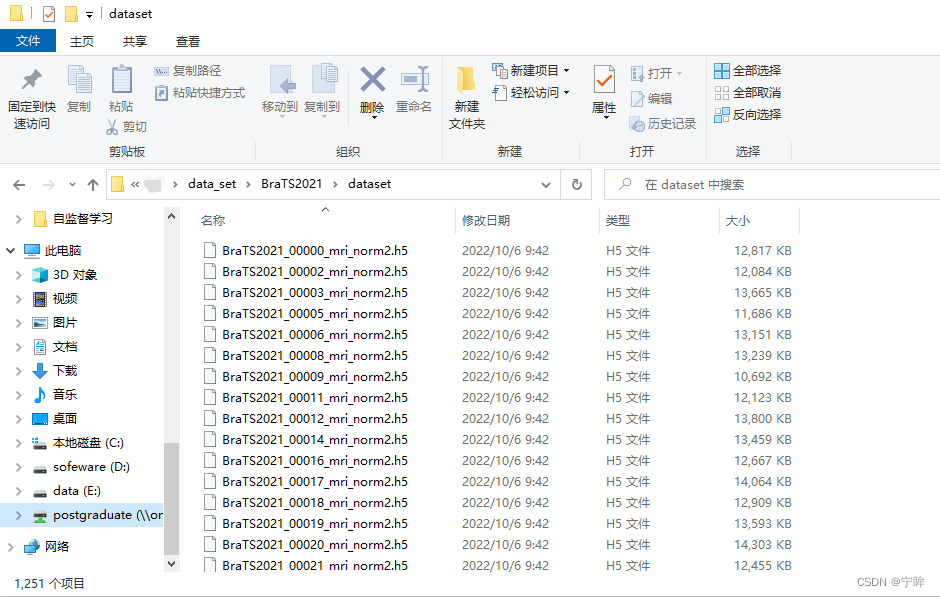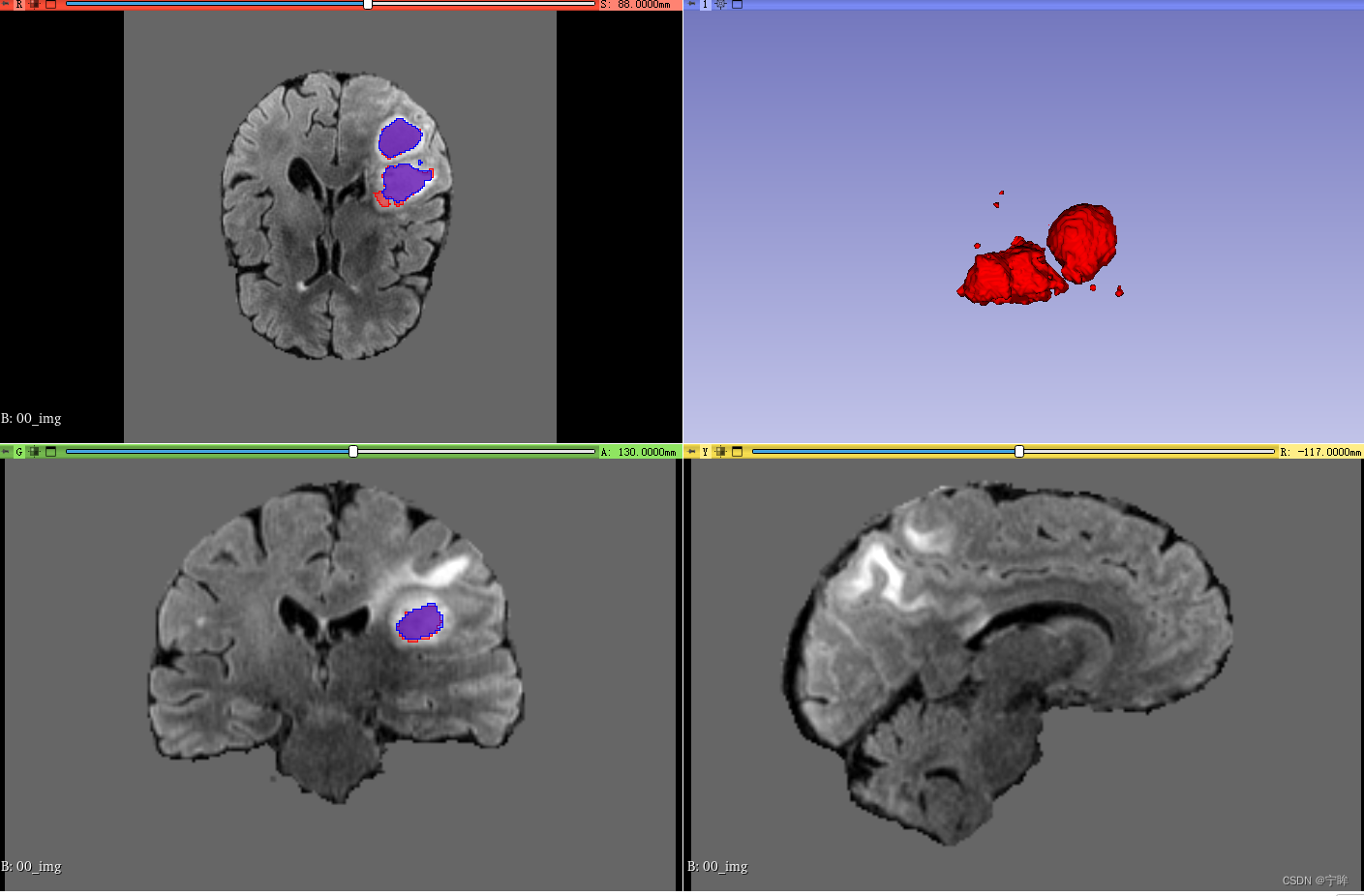Brain Tumor Segmentation (BraTS) Challenge 2021 Homepage
github项目地址 brats-unet: UNet for brain tumor segmentation
BraTS是MICCAI所有比赛中历史最悠久的,到2021年已经连续举办了10年,参赛人数众多,是学习医学图像分割最前沿的平台之一。

1.数据准备
简介:
比赛方提供多机构、多参数多模态核磁共振成像(mpMRI)数据集,包括训练集(1251例)和验证集(219例)以及测试集(530例),一共2000例患者的mpMRI扫描结果。其中训练集包含图像和分割标签,验证集和测试集没有分割标签,验证集被用于公共排行榜,测试集不公开,用作参赛者的最终排名评测。
四种模态数据:flair, t1ce, t1, t2,每个模态的数据大小都为 240 x 240 x 155,且共享分割标签。
分割标签:[0, 1, 2, 4]
- label0:背景(bachground)
- label1:坏疽(NT, necrotic tumor core)
- label2:浮肿区域(ED,peritumoral edema)
- label4:增强肿瘤区域(ET,enhancing tumor)
本次比赛包括两个任务:
- Task1:mpMRI扫描中分割内在异质性脑胶质母细胞瘤区域
- Task2:预测术前基线扫描中的MGMT启动子甲基化状态
本文从数据处理、评价指标、损失函数、模型训练四个方面介绍Task1的整体实现过程
数据集下载地址:
1.官网:BraTS 2021 Challenge 需要注册和申请(包括训练集和验证集)
2.Kaggle:BRaTS 2021 Task 1 Dataset 建议在kaggle上下载,数据集与官网一致(不包括验证集)
数据准备:
下载数据集,解压后如下图所示:

每个病例包含四种模态的MRI图像和分割标签,结构如下:
BraTS2021_00000
├── BraTS2021_00000_flair.nii.gz
├── BraTS2021_00000_seg.nii.gz
├── BraTS2021_00000_t1ce.nii.gz
├── BraTS2021_00000_t1.nii.gz
└── BraTS2021_00000_t2.nii.gz
建议使用3D Slicer查看图像和标签,直观的了解一下自己要用的数据集。
2.数据预处理
每个病例的四种MRI图像大小为 240 x 240 x 155,且共享标签。
鉴于此,我将四种模态的图像合并为一个4D图像(C x H x W x D , C=4),并且和分割标签一起保存为一个
.h5
文件,方便后续处理。
import h5py
import os
import numpy as np
import SimpleITK as sitk
from tqdm import tqdm
# 四种模态的mri图像
modalities =('flair','t1ce','t1','t2')# train
train_set ={'root':'/data/omnisky/postgraduate/Yb/data_set/BraTS2021/data',# 四个模态数据所在地址'out':'/data/omnisky/postgraduate/Yb/data_set/BraTS2021/dataset/',# 预处理输出地址'flist':'train.txt',# 训练集名单(有标签)}
- 将图像保存为32位浮点数(np.float32),标签保存为整数(np.uint8),写入
.h5文件 - 对每张图像的灰度进行标准化,但保持背景区域为0

- 上图是预处理后的图像,背景区域为0
defprocess_h5(path, out_path):""" Save the data with dtype=float32.
z-score is used but keep the background with zero! """# SimpleITK读取图像默认是是 DxHxW,这里转为 HxWxD
label = sitk.GetArrayFromImage(sitk.ReadImage(path +'seg.nii.gz')).transpose(1,2,0)print(label.shape)# 堆叠四种模态的图像,4 x (H,W,D) -> (4,H,W,D)
images = np.stack([sitk.GetArrayFromImage(sitk.ReadImage(path + modal +'.nii.gz')).transpose(1,2,0)for modal in modalities],0)# [240,240,155]# 数据类型转换
label = label.astype(np.uint8)
images = images.astype(np.float32)
case_name = path.split('/')[-1]# case_name = os.path.split(path)[-1] # windows路径与linux不同
path = os.path.join(out_path,case_name)
output = path +'mri_norm2.h5'# 对第一个通道求和,如果四个模态都为0,则标记为背景(False)
mask = images.sum(0)>0for k inrange(4):
x = images[k,...]#
y = x[mask]# 对背景外的区域进行归一化
x[mask]-= y.mean()
x[mask]/= y.std()
images[k,...]= x
print(case_name,images.shape,label.shape)
f = h5py.File(output,'w')
f.create_dataset('image', data=images, compression="gzip")
f.create_dataset('label', data=label, compression="gzip")
f.close()defdoit(dset):
root, out_path = dset['root'], dset['out']
file_list = os.path.join(root, dset['flist'])
subjects =open(file_list).read().splitlines()
names =['BraTS2021_'+ sub for sub in subjects]
paths =[os.path.join(root, name, name +'_')for name in names]for path in tqdm(paths):
process_h5(path, out_path)# breakprint('Finished')if __name__ =='__main__':
doit(train_set)
数据保存在 mri_norm2.h5 文件中,每个 mri_norm2.h5 相当于一个字典,字典的键为 image 和 label ,值为对应的数组。

处理后的数据,可以用下面的几行代码测试一下,记得修改为你自己的路径
import h5py
import numpy as np
p ='/***/data_set/BraTS2021/all/BraTS2021_00000_mri_norm2.h5'
h5f = h5py.File(p,'r')
image = h5f['image'][:]
label = h5f['label'][:]print('image shape:',image.shape,'\t','label shape',label.shape)print('label set:',np.unique(label))# image shape: (4, 240, 240, 155) label shape (240, 240, 155)# label set: [0 1 2 4]
将数据集按照 8:1:1随机划分为训练集、验证集和测试集,将划分后的数据名保存为
.txt
文件
import os
from sklearn.model_selection import train_test_split
# 预处理输出地址
data_path ="/***/data_set/BraTS2021/dataset"
train_and_test_ids = os.listdir(data_path)
train_ids, val_test_ids = train_test_split(train_and_test_ids, test_size=0.2,random_state=21)
val_ids, test_ids = train_test_split(val_test_ids, test_size=0.5,random_state=21)print("Using {} images for training, {} images for validation, {} images for testing.".format(len(train_ids),len(val_ids),len(test_ids)))withopen('/***/data_set/BraTS2021/train.txt','w')as f:
f.write('\n'.join(train_ids))withopen('/***/data_set/BraTS2021/valid.txt','w')as f:
f.write('\n'.join(val_ids))withopen('/***/data_set/BraTS2021/test.txt','w')as f:
f.write('\n'.join(test_ids))
划分结果:
Using 1000 images for training, 125 images for validation, 126 images for testing.
......
BraTS2021_00002_mri_norm2.h5
BraTS2021_00003_mri_norm2.h5
BraTS2021_00014_mri_norm2.h5
......
3.数据增强
下面是我写的
Dataset
类以及一些数据增强方法
整体架构
import os
import torch
from torch.utils.data import Dataset
import random
import numpy as np
from torchvision.transforms import transforms
import h5py
classBraTS(Dataset):def__init__(self,data_path, file_path,transform=None):withopen(file_path,'r')as f:
self.paths =[os.path.join(data_path, x.strip())for x in f.readlines()]
self.transform = transform
def__getitem__(self, item):
h5f = h5py.File(self.paths[item],'r')
image = h5f['image'][:]
label = h5f['label'][:]# print(image.shape)
sample ={'image': image,'label': label}if self.transform:
sample = self.transform(sample)return sample['image'], sample['label']def__len__(self):returnlen(self.paths)defcollate(self, batch):return[torch.cat(v)for v inzip(*batch)]if __name__ =='__main__':from torchvision import transforms
data_path ="/***/data_set/BraTS2021/dataset"
test_txt ="/***/data_set/BraTS2021/test.txt"
test_set = BraTS(data_path,test_txt,transform=transforms.Compose([
RandomRotFlip(),
RandomCrop((160,160,128)),
GaussianNoise(p=0.1),
ToTensor()]))
d1 = test_set[0]
image,label = d1
print(image.shape)print(label.shape)print(np.unique(label))
具体的数据增强方法我列在了下面,包括裁剪、旋转、翻转、高斯噪声、对比度变换和亮度增强的源码,部分代码借鉴了nnUNet的数据增强方法。
随机裁剪
原始图像尺寸为 240 x 240 x 155,但图像周围是有很多黑边的,我将图像裁剪为 160 x 160 x 128
classRandomCrop(object):"""
Crop randomly the image in a sample
Args:
output_size (int): Desired output size
"""def__init__(self, output_size):
self.output_size = output_size
def__call__(self, sample):
image, label = sample['image'], sample['label'](c, w, h, d)= image.shape
w1 = np.random.randint(0, w - self.output_size[0])
h1 = np.random.randint(0, h - self.output_size[1])
d1 = np.random.randint(0, d - self.output_size[2])
label = label[w1:w1 + self.output_size[0], h1:h1 + self.output_size[1], d1:d1 + self.output_size[2]]
image = image[:,w1:w1 + self.output_size[0], h1:h1 + self.output_size[1], d1:d1 + self.output_size[2]]return{'image': image,'label': label}
中心裁剪
classCenterCrop(object):def__init__(self, output_size):
self.output_size = output_size
def__call__(self, sample):
image, label = sample['image'], sample['label'](c,w, h, d)= image.shape
w1 =int(round((w - self.output_size[0])/2.))
h1 =int(round((h - self.output_size[1])/2.))
d1 =int(round((d - self.output_size[2])/2.))
label = label[w1:w1 + self.output_size[0], h1:h1 + self.output_size[1], d1:d1 + self.output_size[2]]
image = image[:,w1:w1 + self.output_size[0], h1:h1 + self.output_size[1], d1:d1 + self.output_size[2]]return{'image': image,'label': label}
随机翻转
旋转可能会导致图像重采样,因为数据集比较充分,我只在{90,180,270}度做一个简单旋转,不涉及重采样。
classRandomRotFlip(object):"""
Crop randomly flip the dataset in a sample
Args:
output_size (int): Desired output size
"""def__call__(self, sample):
image, label = sample['image'], sample['label']
k = np.random.randint(0,4)
image = np.stack([np.rot90(x,k)for x in image],axis=0)
label = np.rot90(label, k)
axis = np.random.randint(1,4)
image = np.flip(image, axis=axis).copy()
label = np.flip(label, axis=axis-1).copy()return{'image': image,'label': label}
高斯噪声
defaugment_gaussian_noise(data_sample, noise_variance=(0,0.1)):if noise_variance[0]== noise_variance[1]:
variance = noise_variance[0]else:
variance = random.uniform(noise_variance[0], noise_variance[1])
data_sample = data_sample + np.random.normal(0.0, variance, size=data_sample.shape)return data_sample
classGaussianNoise(object):def__init__(self, noise_variance=(0,0.1), p=0.5):
self.prob = p
self.noise_variance = noise_variance
def__call__(self, sample):
image = sample['image']
label = sample['label']if np.random.uniform()< self.prob:
image = augment_gaussian_noise(image, self.noise_variance)return{'image': image,'label': label}
对比度变换
- contrast_range:对比度增强的范围
- preserve_range:是否保留数据的取值范围
- per_channel:是否对每个通道的图像分别进行对比度增强
defaugment_contrast(data_sample, contrast_range=(0.75,1.25), preserve_range=True, per_channel=True):ifnot per_channel:
mn = data_sample.mean()if preserve_range:
minm = data_sample.min()
maxm = data_sample.max()if np.random.random()<0.5and contrast_range[0]<1:
factor = np.random.uniform(contrast_range[0],1)else:
factor = np.random.uniform(max(contrast_range[0],1), contrast_range[1])
data_sample =(data_sample - mn)* factor + mn
if preserve_range:
data_sample[data_sample < minm]= minm
data_sample[data_sample > maxm]= maxm
else:for c inrange(data_sample.shape[0]):
mn = data_sample[c].mean()if preserve_range:
minm = data_sample[c].min()
maxm = data_sample[c].max()if np.random.random()<0.5and contrast_range[0]<1:
factor = np.random.uniform(contrast_range[0],1)else:
factor = np.random.uniform(max(contrast_range[0],1), contrast_range[1])
data_sample[c]=(data_sample[c]- mn)* factor + mn
if preserve_range:
data_sample[c][data_sample[c]< minm]= minm
data_sample[c][data_sample[c]> maxm]= maxm
return data_sample
classContrastAugmentationTransform(object):def__init__(self, contrast_range=(0.75,1.25), preserve_range=True, per_channel=True,p_per_sample=1.):
self.p_per_sample = p_per_sample
self.contrast_range = contrast_range
self.preserve_range = preserve_range
self.per_channel = per_channel
def__call__(self, sample):
image = sample['image']
label = sample['label']for b inrange(len(image)):if np.random.uniform()< self.p_per_sample:
image[b]= augment_contrast(image[b], contrast_range=self.contrast_range,
preserve_range=self.preserve_range, per_channel=self.per_channel)return{'image': image,'label': label}
亮度变换
附加亮度从具有μ和σ的高斯分布中采样
defaugment_brightness_additive(data_sample, mu:float, sigma:float, per_channel:bool=True, p_per_channel:float=1.):ifnot per_channel:
rnd_nb = np.random.normal(mu, sigma)for c inrange(data_sample.shape[0]):if np.random.uniform()<= p_per_channel:
data_sample[c]+= rnd_nb
else:for c inrange(data_sample.shape[0]):if np.random.uniform()<= p_per_channel:
rnd_nb = np.random.normal(mu, sigma)
data_sample[c]+= rnd_nb
return data_sample
classBrightnessTransform(object):def__init__(self, mu, sigma, per_channel=True, p_per_sample=1., p_per_channel=1.):
self.p_per_sample = p_per_sample
self.mu = mu
self.sigma = sigma
self.per_channel = per_channel
self.p_per_channel = p_per_channel
def__call__(self, sample):
data, label = sample['image'], sample['label']for b inrange(data.shape[0]):if np.random.uniform()< self.p_per_sample:
data[b]= augment_brightness_additive(data[b], self.mu, self.sigma, self.per_channel,
p_per_channel=self.p_per_channel)return{'image': data,'label': label}
数据类型转换
将Numpy数组转为Tensor
classToTensor(object):"""Convert ndarrays in sample to Tensors."""def__call__(self, sample):
image = sample['image']
label = sample['label']
image = torch.from_numpy(image).float()
label = torch.from_numpy(label).long()return{'image': image,'label': label}
相比其他医学影像数据集,BraTS2021是非常高质量的,对数据增强方法并不是很敏感。
4.评价损失
损失函数:
combination of dice and crossentropy loss

dice loss

- μ是网络的softmax输出
- v是分割标签的one-hot编码
其实就是将计算dice时的
torch.argmax替换为了
torch.softmax
import torch.nn.functional as F
import torch.nn as nn
import torch
from einops import rearrange
classLoss(nn.Module):def__init__(self, n_classes, weight=None, alpha=0.5):"dice_loss_plus_cetr_weighted"super(Loss, self).__init__()
self.n_classes = n_classes
self.weight = weight.cuda()# self.weight = weight
self.alpha = alpha
defforward(self,input, target):
smooth =0.01# 防止分母为0
input1 = F.softmax(input, dim=1)
target1 = F.one_hot(target,self.n_classes)
input1 = rearrange(input1,'b n h w s -> b n (h w s)')
target1 = rearrange(target1,'b h w s n -> b n (h w s)')
input1 = input1[:,1:,:]
target1 = target1[:,1:,:].float()# 以batch为单位计算loss和dice_loss,据说训练更稳定,和上面的公式有出入# 注意,这里的dice不是真正的dice,叫做soft_dice更贴切
inter = torch.sum(input1 * target1)
union = torch.sum(input1)+ torch.sum(target1)+ smooth
dice =2.0* inter / union
loss = F.cross_entropy(input,target, weight=self.weight)
total_loss =(1- self.alpha)* loss +(1- dice)* self.alpha
return total_loss
if __name__ =='__main__':
torch.manual_seed(3)
device = torch.device('cuda'if torch.cuda.is_available()else'cpu')
losser = Loss(n_classes=4, weight=torch.tensor([0.2,0.3,0.25,0.25])).to(device)
x = torch.randn((2,4,16,16,16)).to(device)
y = torch.randint(0,4,(2,16,16,16)).to(device)print(losser(x, y))
评价指标:

dice计算方法:
2
(
A
∩
B
)
A
+
B
2{(A \cap B)}\over{A + B}
A+B2(A∩B)
defDice(output, target, eps=1e-3):
inter = torch.sum(output * target,dim=(1,2,3))+ eps
union = torch.sum(output,dim=(1,2,3))+ torch.sum(target,dim=(1,2,3))+ eps *2
x =2* inter / union
dice = torch.mean(x)return dice
- output: (b, num_class, d, h, w) target: (b, d, h, w)
- dice1(ET):label4
- dice2(TC):label1 + label4
- dice3(WT): label1 + label2 + label4
- 注意,这里的label4已经被替换为3
defcal_dice(output, target):
output = torch.argmax(output,dim=1)
dice1 = Dice((output ==3).float(),(target ==3).float())
dice2 = Dice(((output ==1)|(output ==3)).float(),((target ==1)|(target ==3)).float())
dice3 = Dice((output !=0).float(),(target !=0).float())return dice1, dice2, dice3
5.模型训练
以UNet为例,我把完整代码放在了下面
module:
import torch
import torch.nn as nn
classInConv(nn.Module):def__init__(self, in_ch, out_ch):super(InConv, self).__init__()
self.conv = DoubleConv(in_ch, out_ch)defforward(self, x):
x = self.conv(x)return x
classDown(nn.Module):def__init__(self, in_ch, out_ch):super(Down, self).__init__()
self.mpconv = nn.Sequential(
nn.MaxPool3d(2,2),
DoubleConv(in_ch, out_ch))defforward(self, x):
x = self.mpconv(x)return x
classOutConv(nn.Module):def__init__(self, in_ch, out_ch):super(OutConv, self).__init__()
self.conv = nn.Conv3d(in_ch, out_ch,1)# self.sigmoid = nn.Sigmoid()defforward(self, x):
x = self.conv(x)# x = self.sigmoid(x)return x
classDoubleConv(nn.Module):def__init__(self, in_ch, out_ch):super(DoubleConv, self).__init__()
self.conv = nn.Sequential(
nn.Conv3d(in_ch, out_ch, kernel_size=3, stride=1, padding=1),
nn.BatchNorm3d(out_ch),
nn.ReLU(inplace=True),
nn.Conv3d(out_ch, out_ch, kernel_size=3, stride=1, padding=1),
nn.BatchNorm3d(out_ch),
nn.ReLU(inplace=True))defforward(self, x):
x = self.conv(x)return x
classUp(nn.Module):def__init__(self, in_ch, skip_ch,out_ch):super(Up, self).__init__()
self.up = nn.ConvTranspose3d(in_ch, in_ch, kernel_size=2, stride=2)
self.conv = DoubleConv(in_ch+skip_ch, out_ch)defforward(self, x1, x2):
x1 = self.up(x1)
x = torch.cat([x2, x1], dim=1)
x = self.conv(x)return x
model:
classUNet(nn.Module):def__init__(self, in_channels, num_classes):super(UNet, self).__init__()
features =[32,64,128,256]
self.inc = InConv(in_channels, features[0])
self.down1 = Down(features[0], features[1])
self.down2 = Down(features[1], features[2])
self.down3 = Down(features[2], features[3])
self.down4 = Down(features[3], features[3])
self.up1 = Up(features[3], features[3], features[2])
self.up2 = Up(features[2], features[2], features[1])
self.up3 = Up(features[1], features[1], features[0])
self.up4 = Up(features[0], features[0], features[0])
self.outc = OutConv(features[0], num_classes)defforward(self, x):
x1 = self.inc(x)
x2 = self.down1(x1)
x3 = self.down2(x2)
x4 = self.down3(x3)
x5 = self.down4(x4)
x = self.up1(x5, x4)
x = self.up2(x, x3)
x = self.up3(x, x2)
x = self.up4(x, x1)
x = self.outc(x)return x
if __name__ =='__main__':
x = torch.randn(1,4,160,160,128)
net = UNet(in_channels=4, num_classes=4)
y = net(x)print("params: ",sum(p.numel()for p in net.parameters()))print(y.shape)
Train:
下面是我写的训练函数,具体细节见代码注释
- 优化器:
optim.SGD(model.parameters(),momentum=0.9, lr=0, weight_decay=5e-4) - 学习率余弦衰减:最大学习率0.004,最小学习率0.002,预热10个epoch
- 优化策略可参考我的另一篇博客nnUnet代码解读–优化策略
import os
import argparse
from torch.utils.data import DataLoader
import torch
import torch.optim as optim
from tqdm import tqdm
from BraTS import*from networks.Unet import UNet
from utils import Loss,cal_dice,cosine_scheduler
deftrain_loop(model,optimizer,scheduler,criterion,train_loader,device,epoch):
model.train()
running_loss =0
dice1_train =0
dice2_train =0
dice3_train =0
pbar = tqdm(train_loader)for it,(images,masks)inenumerate(pbar):# update learning rate according to the schedule
it =len(train_loader)* epoch + it
param_group = optimizer.param_groups[0]
param_group['lr']= scheduler[it]# print(scheduler[it])# [b,4,128,128,128] , [b,128,128,128]
images, masks = images.to(device),masks.to(device)# [b,4,128,128,128], 4分割
outputs = model(images)# outputs = torch.softmax(outputs,dim=1)
loss = criterion(outputs, masks)
dice1, dice2, dice3 = cal_dice(outputs,masks)
pbar.desc ="loss: {:.3f} ".format(loss.item())
running_loss += loss.item()
dice1_train += dice1.item()
dice2_train += dice2.item()
dice3_train += dice3.item()
optimizer.zero_grad()
loss.backward()
optimizer.step()
loss = running_loss /len(train_loader)
dice1 = dice1_train /len(train_loader)
dice2 = dice2_train /len(train_loader)
dice3 = dice3_train /len(train_loader)return{'loss':loss,'dice1':dice1,'dice2':dice2,'dice3':dice3}defval_loop(model,criterion,val_loader,device):
model.eval()
running_loss =0
dice1_val =0
dice2_val =0
dice3_val =0
pbar = tqdm(val_loader)with torch.no_grad():for images, masks in pbar:
images, masks = images.to(device), masks.to(device)
outputs = model(images)# outputs = torch.softmax(outputs,dim=1)
loss = criterion(outputs, masks)
dice1, dice2, dice3 = cal_dice(outputs, masks)
running_loss += loss.item()
dice1_val += dice1.item()
dice2_val += dice2.item()
dice3_val += dice3.item()# pbar.desc = "loss:{:.3f} dice1:{:.3f} dice2:{:.3f} dice3:{:.3f} ".format(loss,dice1,dice2,dice3)
loss = running_loss /len(val_loader)
dice1 = dice1_val /len(val_loader)
dice2 = dice2_val /len(val_loader)
dice3 = dice3_val /len(val_loader)return{'loss':loss,'dice1':dice1,'dice2':dice2,'dice3':dice3}deftrain(model,optimizer,scheduler,criterion,train_loader,
val_loader,epochs,device,train_log,valid_loss_min=999.0):for e inrange(epochs):# train for epoch
train_metrics = train_loop(model,optimizer,scheduler,criterion,train_loader,device,e)# eval for epoch
val_metrics = val_loop(model,criterion,val_loader,device)
info1 ="Epoch:[{}/{}] train_loss: {:.3f} valid_loss: {:.3f} ".format(e+1,epochs,train_metrics["loss"],val_metrics["loss"])
info2 ="Train--ET: {:.3f} TC: {:.3f} WT: {:.3f} ".format(train_metrics['dice1'],train_metrics['dice2'],train_metrics['dice3'])
info3 ="Valid--ET: {:.3f} TC: {:.3f} WT: {:.3f} ".format(val_metrics['dice1'],val_metrics['dice2'],val_metrics['dice3'])print(info1)print(info2)print(info3)withopen(train_log,'a')as f:
f.write(info1 +'\n'+ info2 +' '+ info3 +'\n')ifnot os.path.exists(args.save_path):
os.makedirs(args.save_path)
save_file ={"model": model.state_dict(),"optimizer": optimizer.state_dict()}if val_metrics['loss']< valid_loss_min:
valid_loss_min = val_metrics['loss']
torch.save(save_file,'results/UNet.pth')else:
torch.save(save_file,os.path.join(args.save_path,'checkpoint{}.pth'.format(e+1)))print("Finished Training!")defmain(args):
torch.manual_seed(args.seed)# 为CPU设置种子用于生成随机数,以使得结果是确定的
torch.cuda.manual_seed_all(args.seed)# 为所有的GPU设置种子,以使得结果是确定的
torch.backends.cudnn.deterministic =True
torch.backends.cudnn.benchmark =True
os.environ['CUDA_VISIBLE_DEVICES']='0'
device = torch.device('cuda'if torch.cuda.is_available()else'cpu')# data info
patch_size =(160,160,128)
train_dataset = BraTS(args.data_path,args.train_txt,transform=transforms.Compose([
RandomRotFlip(),
RandomCrop(patch_size),
GaussianNoise(p=0.1),
ToTensor()]))
val_dataset = BraTS(args.data_path,args.valid_txt,transform=transforms.Compose([
CenterCrop(patch_size),
ToTensor()]))
test_dataset = BraTS(args.data_path,args.test_txt,transform=transforms.Compose([
CenterCrop(patch_size),
ToTensor()]))
train_loader = DataLoader(dataset=train_dataset, batch_size=args.batch_size, num_workers=12,# num_worker=4
shuffle=True, pin_memory=True)
val_loader = DataLoader(dataset=val_dataset, batch_size=args.batch_size, num_workers=12, shuffle=False,
pin_memory=True)
test_loader = DataLoader(dataset=test_dataset, batch_size=args.batch_size, num_workers=12, shuffle=False,
pin_memory=True)print("using {} device.".format(device))print("using {} images for training, {} images for validation.".format(len(train_dataset),len(val_dataset)))# img,label = train_dataset[0]# 1-坏疽(NT,necrotic tumor core),2-浮肿区域(ED,peritumoral edema),4-增强肿瘤区域(ET,enhancing tumor)# 评价指标:ET(label4),TC(label1+label4),WT(label1+label2+label4)
model = UNet(in_channels=4,num_classes=4).to(device)
criterion = Loss(n_classes=4, weight=torch.tensor([0.2,0.3,0.25,0.25])).to(device)
optimizer = optim.SGD(model.parameters(),momentum=0.9, lr=0, weight_decay=5e-4)
scheduler = cosine_scheduler(base_value=args.lr,final_value=args.min_lr,epochs=args.epochs,
niter_per_ep=len(train_loader),warmup_epochs=args.warmup_epochs,start_warmup_value=5e-4)# 加载训练模型if os.path.exists(args.weights):
weight_dict = torch.load(args.weights, map_location=device)
model.load_state_dict(weight_dict['model'])
optimizer.load_state_dict(weight_dict['optimizer'])print('Successfully loading checkpoint.')
train(model,optimizer,scheduler,criterion,train_loader,val_loader,args.epochs,device,train_log=args.train_log)# metrics1 = val_loop(model, criterion, train_loader, device)
metrics2 = val_loop(model, criterion, val_loader, device)
metrics3 = val_loop(model, criterion, test_loader, device)# 最后再评价一遍所有数据,注意,这里使用的是训练结束的模型参数# print("Train -- loss: {:.3f} ET: {:.3f} TC: {:.3f} WT: {:.3f}".format(metrics1['loss'], metrics1['dice1'],metrics1['dice2'], metrics1['dice3']))print("Valid -- loss: {:.3f} ET: {:.3f} TC: {:.3f} WT: {:.3f}".format(metrics2['loss'], metrics2['dice1'], metrics2['dice2'], metrics2['dice3']))print("Test -- loss: {:.3f} ET: {:.3f} TC: {:.3f} WT: {:.3f}".format(metrics3['loss'], metrics3['dice1'], metrics3['dice2'], metrics3['dice3']))if __name__ =='__main__':
parser = argparse.ArgumentParser()
parser.add_argument('--num_classes',type=int, default=4)
parser.add_argument('--seed',type=int, default=21)
parser.add_argument('--epochs',type=int, default=60)
parser.add_argument('--warmup_epochs',type=int, default=10)
parser.add_argument('--batch_size',type=int, default=1)
parser.add_argument('--lr',type=float, default=0.004)
parser.add_argument('--min_lr',type=float, default=0.002)
parser.add_argument('--data_path',type=str, default='/***/data_set/BraTS2021/dataset')
parser.add_argument('--train_txt',type=str, default='/***/data_set/BraTS2021/train.txt')
parser.add_argument('--valid_txt',type=str, default='/***/data_set/BraTS2021/valid.txt')
parser.add_argument('--test_txt',type=str, default='/***/data_set/BraTS2021/test.txt')
parser.add_argument('--train_log',type=str, default='results/UNet.txt')
parser.add_argument('--weights',type=str, default='results/UNet.pth')
parser.add_argument('--save_path',type=str, default='checkpoint/UNet')
args = parser.parse_args()
main(args)
训练集1000张,验证集125张,测试集126张。保存在验证集上损失最小的模型。
6.实验结果

训练30轮的loss曲线如上图所示,下面是我用不同的模型训练60轮,在测试集上的评价指标:
3D MRI Brain Tumor Segmentation(BraTS2021)
网络模型三维数据大小ETTCWT均值UNet160×160×1280.8390.8770.9070.874Attention UNet160×160×1280.8500.8770.9150.881
- Attention UNet在UNet的基础上,在上采样模块引入像素注意力。
7.滑动推理
加载训练好的权重,采用滑动窗口法进行推理,代码见
inference.py
deftest_single_case(net, image, stride_xy, stride_z, patch_size, num_classes=1):# print(image.shape)
c, ww, hh, dd = image.shape
sx = math.ceil((ww - patch_size[0])/ stride_xy)+1
sy = math.ceil((hh - patch_size[1])/ stride_xy)+1
sz = math.ceil((dd - patch_size[2])/ stride_z)+1# print("{}, {}, {}".format(sx, sy, sz))
score_map = np.zeros((num_classes,)+ image.shape[1:]).astype(np.float32)
cnt = np.zeros(image.shape[1:]).astype(np.float32)for x inrange(0, sx):
xs =min(stride_xy*x, ww-patch_size[0])for y inrange(0, sy):
ys =min(stride_xy * y,hh-patch_size[1])for z inrange(0, sz):
zs =min(stride_z * z, dd-patch_size[2])
test_patch = image[:,xs:xs+patch_size[0], ys:ys+patch_size[1], zs:zs+patch_size[2]]
test_patch = np.expand_dims(test_patch,axis=0).astype(np.float32)
test_patch = torch.from_numpy(test_patch).cuda()
y1 = net(test_patch)
y = F.softmax(y1, dim=1)
y = y.cpu().data.numpy()
y = y[0,:,:,:,:]
score_map[:, xs:xs+patch_size[0], ys:ys+patch_size[1], zs:zs+patch_size[2]] \
= score_map[:, xs:xs+patch_size[0], ys:ys+patch_size[1], zs:zs+patch_size[2]]+ y
cnt[xs:xs+patch_size[0], ys:ys+patch_size[1], zs:zs+patch_size[2]] \
= cnt[xs:xs+patch_size[0], ys:ys+patch_size[1], zs:zs+patch_size[2]]+1
score_map = score_map/np.expand_dims(cnt,axis=0)
label_map = np.argmax(score_map, axis =0)return label_map, score_map

以标签1(NT, necrotic tumor core)为例,上图中红色的是金标签,蓝色的是UNet预测结果
确实,脑肿瘤分割相比其他三维分割任务,结果要好太多了,是一个非常适合练手的项目。感兴趣的同学可以按照我的步骤复现一下,效果也不会差。
代码我都放在上面了,码字不易,有用的话还请点个赞,后续也会更新图像分割和深度学习方面的内容,欢迎交流讨论。
版权归原作者 宁眸 所有, 如有侵权,请联系我们删除。